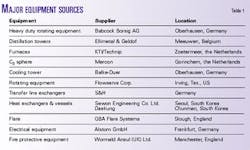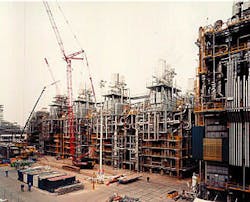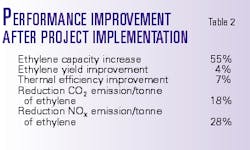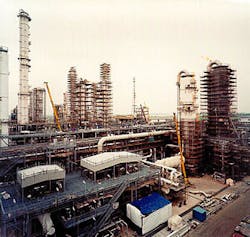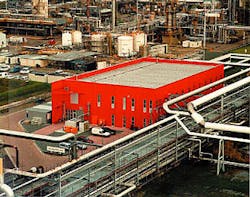Dow Chemical Co., Midland, Mich., is in the final stages of constructing new ethylene capacity via extensive upgrades to its operations in Terneuzen, the Netherlands.
The completion of this project will break the region's "expansion drought," said Theo Walthie, Dow's president of hydrocarbons and energy (HC&E) and ethylene oxide and glycols. It marks the first major ethylene expansion in northwestern Europe since mid-1990.
With the new capacity coming online in fourth quarter 2001, Dow's total ethylene capacity at Terneuzen will increase by 600,000 tonnes. The facility will become the largest naphtha-cracking ethylene site in the world with annual production of 1.7 million tonnes. Dow invested $500 million in this world-scale expansion.
"Our Terneuzen project supports Dow's vision of the new chemical industry in Europe as stronger economies and growing market segments in Central Europe drive greater demand for plastics," said Christopher Gann, Dow's vice-president, olefins and feedstocks.
The expansion will also increase production of polymer-grade propylene, heavy and light gasoline, pyrolysis gas, crude C4, carbon-black feedstock, high-pressure methane, hydrogen, tail gas, and ethane and propane recycle.
European presence
In the global ethylene marketplace, supply has been increasing more quickly than demand with a wave of new capacity coming online this year, mostly in the US and the Middle East. Europe faces a different situation, however. Instead of growing its export position, Europe has become a major marketplace of its own, according to Walthie. As a result, ethylene expansion in Europe has been almost nonexistent for years.
Dow primarily supplies ethylene for use in its own downstream production of plastics and chemicals. Growing demand for Dow's derivative products helped drive the decision to expand. Once the new capacity is brought online, Dow will be able to meet all its ethylene needs in Europe internally.
The additional ethylene production supports growth in Dow's derivative plants. By 2003, all of the ethylene produced in Terneuzen will be used captively. The company board recently approved plans to build a new 300,000-tonne polyethylene plant in Terneuzen to meet increasing demand for a wide range of polyethylene resins. The new capacity will provide ethylene to directly support this derivative expansion.
Expanding the site's ethylene capacity will also support several other planned expansions in Terneuzen. In the fourth quarter of 2001, the site's cumene plant will start up with a 300,000-tonne expansion. Production of magnum acrylonitrile-butadiene-styrene (ABS) resins will increase by 75,000 tonnes with an expansion that will start up in late 2002. The site's latex production will increase as well.
Dow's businesses are responding to market growth, explained Gann.
The Terneuzen expansion brings Dow several key advantages. The new revamped furnaces operate with either gas or liquid feedstock, providing greater flexibility. This allows Dow to adjust quickly to changes and needs in the marketplace and to manage feedstocks according to what is currently best in northwest Europe. Online optimization supported by on-site process research will maximize the value generation in the expanded facilities.
"Terneuzen is our most flexible location in the region," Jan Dahlmans, Dow's project director, said. "Not only does it allow us to choose the most efficient feedstocks, its physical location allows Dow to manage regional surpluses and deficits easily."
Engineering and construction
To work in the existing site space at Terneuzen, the new ethylene capacity required a creative approach to construction that helped minimize the investment.
The total project required about 3.5 million working hr. At the peak of construction, 1,400 people were working on the project. Once the new capacity is fully functioning, the site will employ 2,100 people.
Table 1 lists the sources of major equipment purchased for the expansion.
Four major project segments make up the expansion effort: revamping the furnaces of existing production, building a new separation section, integrating the expansion into the existing infrastructure, and consolidating the process controls for the light hydrocarbons operations into a single control center.
- Furnaces. To increase ethylene production by 600,000 tonnes, Dow revamped 18 Lummus furnaces using KTI/Technip technology to double their capacities and improve performance. Eleven of the revamped furnaces were lined up with the new separation section. The other seven improved the efficiency of the existing unit (Fig. 1).
The design process began in January 1999. Construction began in July 2000 and was complete in July 2001.
The furnaces maximize thermal efficiency within the physical limitations of new high-pressure steam superheat convection banks. The new design allowed the removal of the old stacks, drastically changing the Terneuzen skyline.
Besides improving ethylene yield, the applied technology improves propylene yield by 15%. It also significantly reduces energy use and NOx emissions (Table 2).
- Separation train. The separation train for the new capacity was designed and built with Kellogg Brown & Root technology (Fig. 2).
Design work began in March 1999, and construction will be completed in fourth quarter 2001. Stork Engineering & Contractors handled the detail engineering, procurement, and construction; however, when the company was sold in January 2001, Dow took over these responsibilities.
This part of the project includes several components that will handle the gas from 11 of the revamped furnaces using proven technology based on Dow's experiences with a liquid-cracking unit in Freeport, Tex.
The oil and water quench system cools the cracked gas from the furnaces to start the separation process. The quench oil recovers heat from the cracked gas and uses that heat to generate medium-pressure steam in the dilution steam system, optimizing this process.
The cracked-gas compressor includes a gasoline stripper column and a caustic tower that removes acid gases from the product stream. Dryers remove the water in the cracked gas as well.
The depropanizer column separates the heavier components from the mix. A mercury-removal system in the lighter product stream protects the acetylene reactor catalyst, which partially hydrogenates C2 and C3 acetylenes to form ethylene and propylene. The process uses an improved ethylene-recovery system.
- Infrastructure. Because infrastructure usually represents 40% of the investment in new capacity, Dow was able to conserve costs by using the existing infrastructure. The tie-in points, start-up and storage lines, product lines, and other groundwork were built within the existing operations structure to connect the expansion to the rest of the Terneuzen site.
Planning and engineering, done primarily by Dow, began in June 1998. The construction phase began in January 2000 and will be completed in August 2001.
Completed after the first year of construction, a new propylene storage sphere, with a capacity of 5,000 cu m, will contain the additional propylene produced at the site. From the storage sphere, it will be piped as needed to other Terneuzen derivative plants for processing.
The existing pumps in the naphtha feed system and at the current pipeline booster stations will be upgraded or replaced. Pipelines carry ethylene from Terneuzen to Antwerp. New booster stations will be added to this line to increase the pipeline capacity to 80 tonnes/hr.
Another pipeline system carries propylene to Antwerp and Rotterdam, and a new booster station will increase this line's capacity to 95 tonnes/hr.
- Control room. The process controls for all Terneuzen ethylene plants will be centralized in a single new control center with a crew of 30 engineers (Fig. 3).
Construction and upgrades began in March 1999. The control room will be completed when it starts up the new ethylene capacity in fourth quarter 2001. The uniformity of software and process control standards will increase the efficiency of the entire light hydrocarbons system.
The consolidated control room will also control aromatics and butadiene units. It will be the largest single control room within Dow's global operations.
Environment and safety
The Terneuzen expansion exceeds government and international standards for the environment and had an excellent safety record. The project also enhanced the environmental performance of the existing units.
"Dow's guidelines are that all our operations meet applicable government or Dow environment, health, and safety standards, whichever are the more stringent," Gann said.
In the Netherlands, the government sets strict standards, which have become more exacting in recent years. To receive permits, Dow must demonstrate compliance with these standards.
Dow submitted an environmental impact report describing the environmental and safety impact of the new investment during construction and after start-up, Dahlmans said. The report detailed the impact of the project on water, air, soil, noise, energy, and waste streams, including waste disposal and control of air emissions.
Dow's report also described emergency and safety plans and equipment. The building permit process could not be started until the government authorities approved Dow's environmental impact report.
At the Terneuzen ethylene plants, waste is either recycled or disposed of as required. Some of the waste material can be returned to the furnaces to be recracked or reburned. Professional waste contractors handle disposable waste.
Enhancements to the site included construction of a new 71-m high cooling tower with a closed water-cooling system (see cover photo). Completed in 1 year, the tower cools water and recycles it back into the process, with less impact on the environment than seawater cooling. The new cooling tower also helps lower maintenance costs. The hourly water flow through the tower equals the content of six Olympic-size swimming pools. Large ventilators at the bottom of the tower reduced the necessary height by at least 30 m.
New, state-of-the-art low NOx flat flame burners in the furnaces help reduce emissions by 75%/tonne of ethylene produced. The burner design provides a more complete combustion, resulting in fewer emissions.
The new flare system includes a safety mechanism that captures and collects air emissions. The release of these emissions is carefully controlled, eliminating the need to flare. "Dow is committed to protecting a good relationship with our neighbors in Terneuzen, and we made a specific investment to include the features that would allow us to operate without the need for noisy flaring, which can be disruptive to the community," said Dahlmans.
In addition, a community awareness program builds understanding of the plant and promotes open dialogue between Dow and the surrounding community. Dow management works closely with the community to provide updates on activity at the site.
According to Dahlmans, Dow's occupational safety performance ranks at the top of the chemical industry, which has the best occupational safety performance of any industry, according to the US Occupational Safety and Health Administration (OSHA) guidelines. Expansion at the Terneuzen site is consistent with this ranking with excellent safety performance: 3 million hr of construction without a lost time injury and a 0.5 incident frequency rate.
Rewards and incentives encourage contractors to comply with Dow's safety standards. For the Terneuzen project, Dow invested in safety bonuses and incentives worth $4 million to reward contractors for excellent safety performance.

